Tea Estates in South India: A Beginner’s Travel Guide
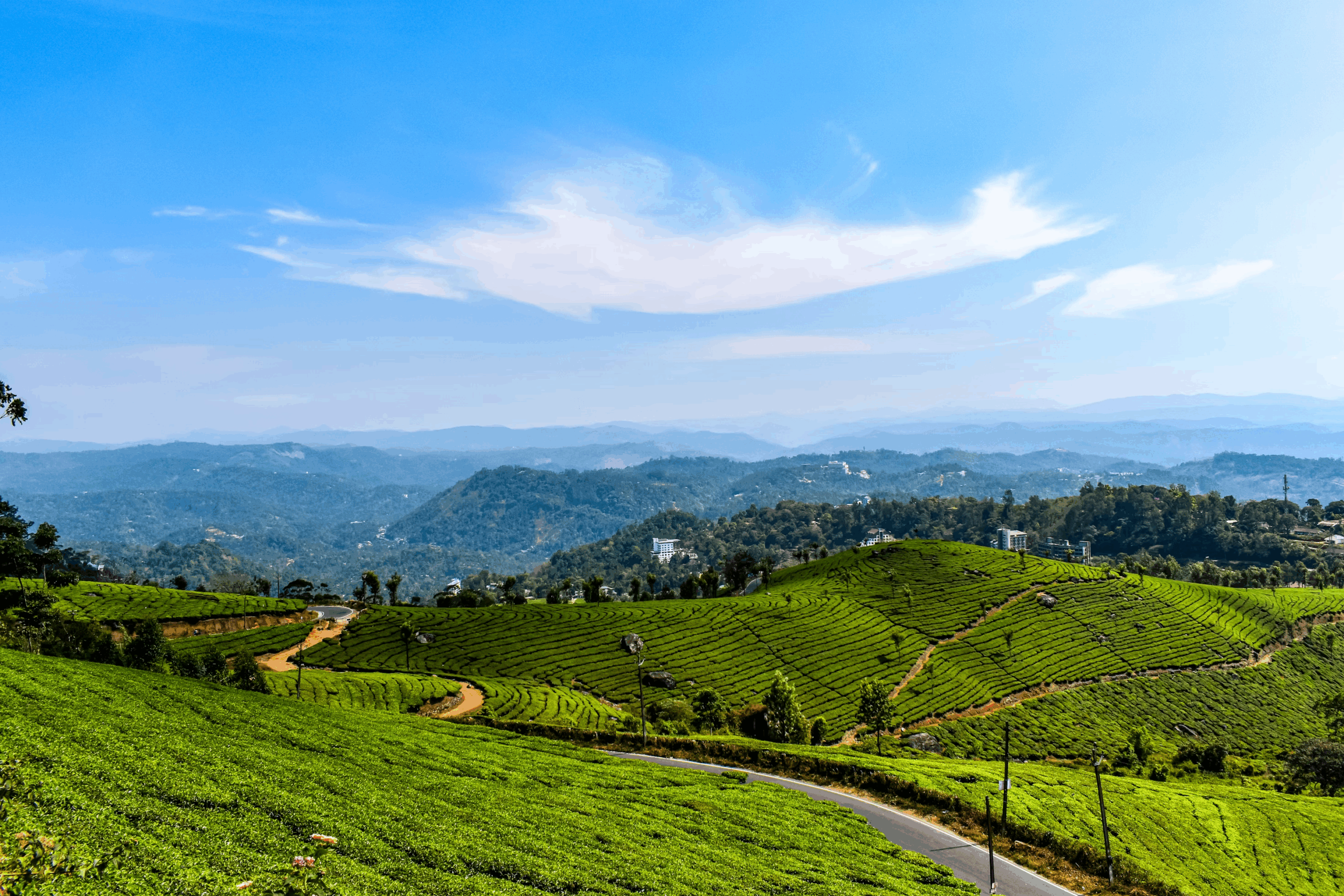
Imagine waking up to mist-covered rolling hills painted in every shade of green imaginable, where the air carries the delicate aroma of fresh tea leaves and morning dew. This isn’t a dream — it’s the reality that awaits you in South India’s magnificent tea estates, where centuries-old traditions meet breathtaking natural beauty in ways that transform ordinary travelers into passionate tea enthusiasts.
If you’ve ever wondered what lies beyond that perfect cup of morning tea, South India’s tea gardens offer immersive experiences that go far deeper than simple sightseeing. From learning the intricate art of tea processing to staying in plantation bungalows where time seems to slow down, these emerald landscapes provide the perfect introduction to India’s rich tea heritage while offering some of the most scenic and peaceful getaways in the country.
In this Blog
Best Tea Estates in South India: Introduction to Plantation Tourism
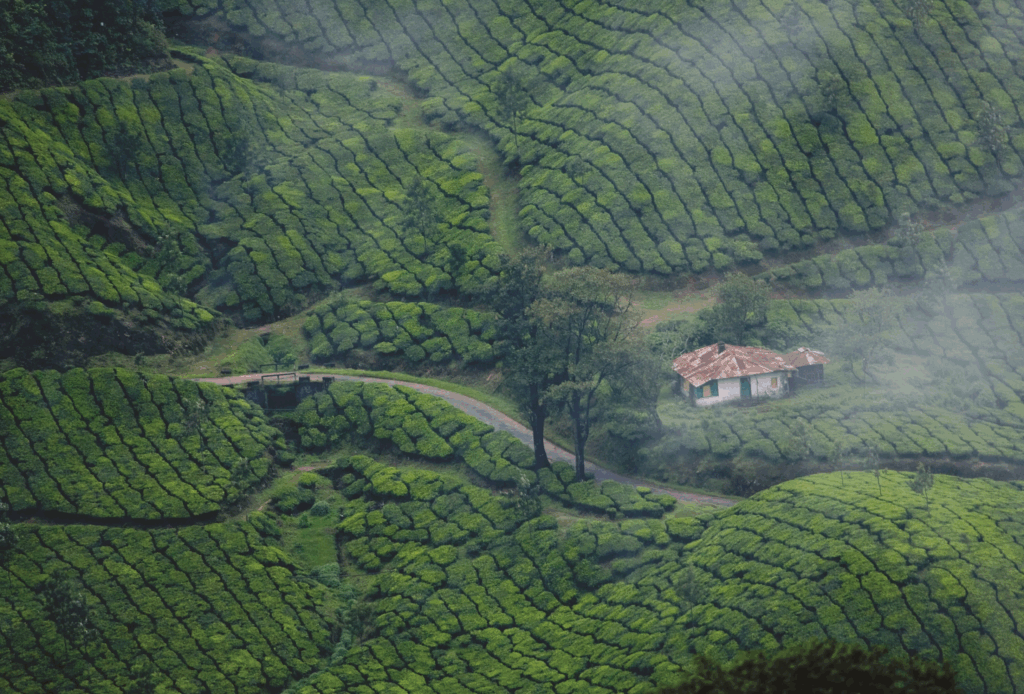
South India’s tea plantation tourism represents a unique travel segment where agriculture, history, and natural beauty converge to create experiences that educate, inspire, and rejuvenate simultaneously. Unlike typical tourist attractions, tea estates offer authentic insights into rural life, sustainable farming practices, and cultural traditions that have shaped these regions for over 150 years.
The Western Ghats’ perfect combination of altitude, climate, and soil conditions has made South India one of the world’s premier tea-producing regions. From Kerala’s high-altitude gardens producing delicate flavors to Tamil Nadu’s robust Nilgiri teas, each region offers distinct varieties and experiences that reflect local geography and cultural influences.
Best Time to Visit Tea Estates in South India
The ideal time for exploring South India tea gardens varies by region, but generally, October through March offers the most pleasant weather conditions for plantation tours and outdoor activities. During these months, temperatures remain comfortable for walking through estates, while clear skies provide optimal photography opportunities and panoramic mountain views.
Post-monsoon months (October-November) showcase tea gardens at their most lush and vibrant, with waterfalls at full flow and vegetation at peak greenness. Winter months (December-February) offer the most comfortable temperatures for extended outdoor exploration, while March marks the beginning of the plucking season in many estates.
Monsoon months (June-September) present a different kind of beauty, with mist-shrouded hills and dramatic weather patterns, though outdoor activities may be limited. However, this season offers unique opportunities to witness the rain-fed growth cycles that make these regions so fertile and productive.
What to Expect on Tea Plantation Tours
Tea plantation tours typically begin with guided walks through manicured tea gardens, where expert guides explain different tea varieties, growing conditions, and harvesting techniques. Most tours include visits to processing facilities where visitors witness the transformation from fresh leaves to finished tea through traditional methods that have remained largely unchanged for generations.
Interactive experiences often include tea plucking demonstrations, where visitors can try their hand at selecting the perfect “two leaves and a bud” that define quality tea. Many estates offer cupping sessions — professional tea tasting experiences that teach visitors to identify flavor profiles, aromas, and quality indicators that distinguish premium teas.
Cultural components frequently involve interactions with tea garden workers, providing insights into daily life in plantation communities. Some estates arrange traditional meals prepared by local families, offering authentic regional cuisines that reflect the multicultural heritage of these mountain communities.
Places to Visit in Munnar: Kerala’s Famous Tea Gardens
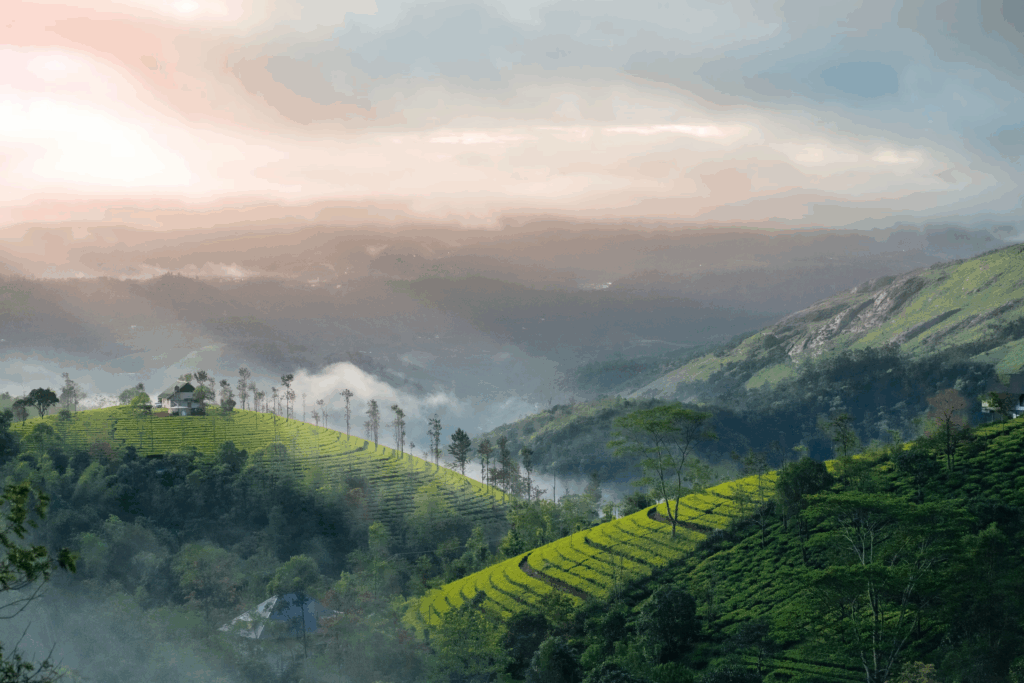
Munnar stands as South India’s most famous tea destination, where rolling hills covered in meticulously maintained tea bushes create some of India’s most photographed landscapes. This hill station’s elevation of 1,600 meters provides ideal growing conditions for high-quality tea while offering visitors cool mountain air and spectacular scenic beauty.
The town’s colonial heritage remains visible in British-era bungalows, winding mountain roads, and tea estate infrastructure that continues operating much as it did during the Raj period. Munnar’s tea gardens produce some of India’s finest high-grown teas, known for their delicate flavors and aromatic qualities that reflect the region’s unique terroir.
Best Tea Plantations to Visit in Munnar
Kolukkumalai Tea Estate, situated at 7,900 feet above sea level, holds the distinction of being the world’s highest organic tea plantation. The estate offers guided tours that include visits to the original 1930s tea factory, where traditional manufacturing processes create unique flavor profiles. The early morning jeep safari to reach this estate becomes an adventure in itself, with sunrise views that stretch across three states.
Lockhart Tea Museum and Factory provides comprehensive introductions to tea processing, from withering and rolling to fermentation and drying. The museum houses vintage equipment and historical photographs that chronicle Munnar’s tea development, while the adjacent factory demonstrates modern processing techniques that maintain traditional quality standards.
Tata Tea Museum offers insights into one of India’s largest tea companies, with exhibits covering tea plantation history, processing evolution, and the socio-economic impact of tea cultivation on local communities. The museum’s collection includes antique tea processing equipment, historical documents, and interactive displays that make tea history accessible and engaging.
Tea Museum and Tasting Experiences in Munnar
The Tea Museum in Munnar provides comprehensive education about tea cultivation, processing, and cultural significance through well-curated exhibits and live demonstrations. Visitors can observe traditional tea manufacturing processes while learning about quality control measures that ensure consistency in tea production.
Professional tea tasting sessions, conducted by certified tea tasters, teach visitors to identify different tea grades, flavor characteristics, and brewing techniques that maximize each variety’s potential. These experiences often include comparisons between different estates’ products, highlighting how altitude, soil composition, and processing methods influence final flavors.
Many estates offer take-home packages featuring their finest teas, along with brewing instructions and storage recommendations that help visitors recreate authentic tea experiences at home. These purchases directly support local tea gardens while providing lasting memories of the Munnar experience.
Homestays in Munnar Near Tea Estates
Staying in tea plantation bungalows or nearby homestays provides immersive experiences that extend beyond daytime tours. Many properties offer early morning plantation walks, where guests can witness the sunrise illuminating tea-covered hills while observing the beginning of daily harvesting activities.
Traditional plantation bungalows, often converted colonial-era managers’ houses, provide authentic accommodation experiences with period furniture, fireplaces, and verandas overlooking endless tea gardens. These properties frequently include home-cooked meals featuring local ingredients and traditional Kerala cuisine prepared by families with generational connections to tea cultivation.
Things to Do in Ooty: Tamil Nadu’s Hill Station Tea Experience
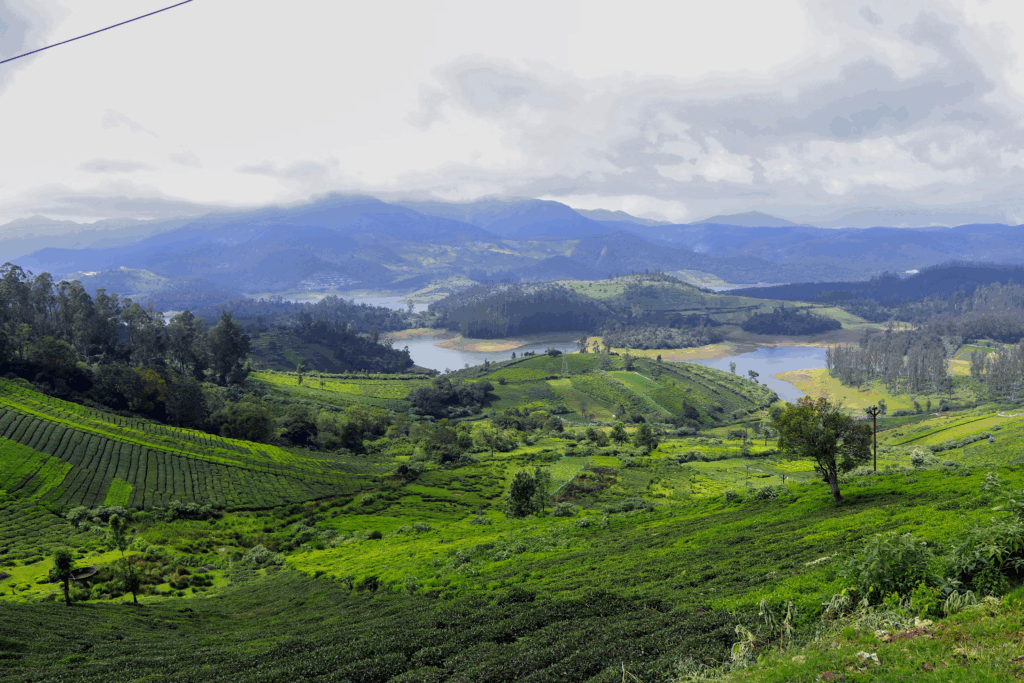
Ooty’s tea gardens offer different experiences from Munnar, with Nilgiri tea varieties known for their bright, citrusy flavors and robust character. The region’s unique elevation and climate produce teas particularly suited for blending, making Ooty estates important suppliers for many international tea brands.
The Nilgiri Hills’ British colonial heritage remains particularly evident in Ooty, where tea cultivation began in the 1850s and helped establish the hill station as a major summer retreat. Today’s visitors can explore this history while enjoying contemporary tea tourism experiences that blend heritage with modern comfort.
Famous Tea Estates in Ooty and Coonoor
Sim’s Park area tea estates offer accessible touring experiences with well-maintained paths suitable for families and elderly visitors. These estates demonstrate sustainable farming practices while providing educational experiences about environmental conservation in tea cultivation.
Dolphin’s Nose viewpoint provides spectacular panoramic views of tea gardens stretching across multiple valleys, creating natural amphitheaters of green that showcase the scale and beauty of Nilgiri tea cultivation. The viewpoint’s elevation offers photography opportunities that capture the geometric patterns created by tea terracing across hillsides.
Coonoor’s surrounding tea estates offer more intimate experiences, with smaller family-owned gardens providing personalized tours and direct interactions with plantation owners. These experiences often include home-style meals and overnight stays in plantation guest houses that provide authentic insights into tea garden life.
Nilgiri Tea Trail and Scenic Tea Garden Routes
The Nilgiri Mountain Railway journey through tea gardens provides unique perspectives on plantation landscapes while offering heritage train experiences that connect multiple tea-growing regions. The toy train’s slow pace allows for detailed observation of tea cultivation practices and worker activities that define daily life in these hills.
Scenic driving routes connecting Ooty, Coonoor, and surrounding tea estates offer self-guided exploration opportunities with multiple stopping points for photography, tea purchases, and informal interactions with plantation workers. These routes frequently pass through different elevation zones, showcasing how altitude affects tea varieties and growing conditions.
Tea Factory Tours and Processing Experiences
Nilgiri tea factories often specialize in CTC (Crush, Tear, Curl) processing methods that create the robust, full-bodied teas popular in Indian markets and international blends. Factory tours demonstrate these mechanical processes while explaining quality control measures that ensure consistency in large-scale production.
Some estates offer hands-on experiences where visitors can participate in tea processing steps, from sorting fresh leaves to operating traditional rolling machines. These interactive experiences provide deeper appreciation for the skill and precision required in tea manufacturing.
Places to Visit in Coorg: Karnataka’s Tea and Coffee Plantations
Coorg’s unique position as both a coffee and tea growing region provides visitors with comparative experiences that highlight how different crops thrive in similar climatic conditions. The region’s tea estates often operate alongside coffee plantations, offering integrated tours that showcase both agricultural traditions.
The area’s biodiversity extends beyond commercial crops to include spice gardens, rainforest patches, and wildlife corridors that demonstrate sustainable agriculture’s environmental benefits. Coorg’s tea estates frequently emphasize organic farming practices and environmental conservation as integral parts of their operations.
Best Tea Estate Tours in Coorg
Abbey Falls area tea gardens combine natural beauty with agricultural tourism, offering hiking trails that connect tea estates with waterfalls and forest areas. These tours often include bird watching opportunities and nature photography sessions that capture Coorg’s diverse ecosystem.
Madikeri region tea estates provide cultural experiences that include interactions with Kodava communities, whose traditional agricultural knowledge contributes to successful tea cultivation. These experiences often feature traditional Kodava meals and cultural performances that provide insights into local heritage.
Coorg Tea Gardens and Coffee Plantation Combinations
Integrated plantation tours demonstrate how tea and coffee cultivation complement each other environmentally and economically. Visitors learn about crop rotation, shade management, and sustainable farming practices that maximize land use while maintaining soil health.
Tasting sessions comparing tea and coffee from the same estates highlight how terroir affects different crops, providing educational experiences that appeal to both tea and coffee enthusiasts. These sessions often include discussions about global markets, fair trade practices, and the economic impact of sustainable agriculture on local communities.
Tourist Places in Wayanad: Kerala’s Hidden Tea Destinations
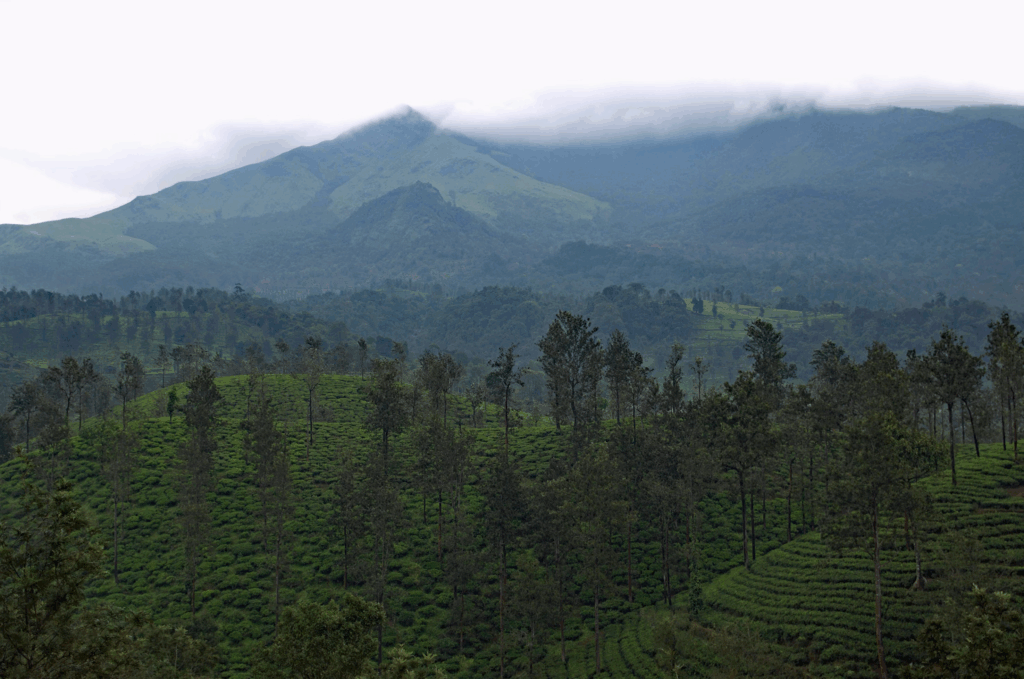
Wayanad’s tea estates offer more intimate experiences than the larger, more commercial operations in Munnar. The region’s focus on organic farming and sustainable practices attracts visitors interested in environmental conservation and traditional agricultural methods.
The area’s tribal heritage adds cultural dimensions to tea tourism, with opportunities to learn about indigenous knowledge systems that contribute to successful tea cultivation. Wayanad’s tea estates often emphasize community involvement and cultural preservation as integral parts of their operations.
Offbeat Tea Estates and Spice Gardens in Wayanad
Small-scale tea gardens in Wayanad frequently operate as family businesses, offering personalized attention and authentic insights into tea cultivation challenges and rewards. These intimate settings provide opportunities for detailed discussions about organic farming, market dynamics, and the personal stories behind tea production.
Integrated spice and tea gardens demonstrate polyculture farming systems that maximize biodiversity while producing multiple crops. Visitors can observe how pepper, cardamom, and other spices grow alongside tea bushes, creating complex ecosystems that support sustainable agriculture.
Tribal Culture and Tea Heritage Experiences
Wayanad’s indigenous communities have contributed traditional ecological knowledge that enhances modern tea cultivation practices. Cultural exchanges often include demonstrations of traditional farming techniques, medicinal plant knowledge, and sustainable resource management practices.
Community-based tourism initiatives provide direct economic benefits to tribal families while offering visitors authentic cultural experiences. These programs often include traditional meals, cultural performances, and craft demonstrations that showcase the rich heritage of Wayanad’s indigenous communities.
South India Tea Plantation Tourism: Cultural Experiences
The cultural aspects of tea plantation tourism extend far beyond agricultural education to encompass social history, community development, and cultural preservation efforts that make these regions unique travel destinations.
Tea Picking and Traditional Processing Methods
Hands-on tea picking experiences teach visitors about the skill and precision required to select quality tea leaves. Expert pickers often demonstrate techniques passed down through generations, highlighting how human expertise remains irreplaceable despite technological advances.
Traditional processing demonstrations often include stone crushing, hand rolling, and sun-drying methods that produce unique flavor profiles. These traditional techniques, while labor-intensive, create artisanal teas that command premium prices and appeal to connoisseurs seeking authentic experiences.
Local Communities and Tea Garden Life
Tea estate communities often represent multicultural heritage, with workers from different states and backgrounds creating diverse cultural environments. Visitors can observe how different cultural traditions coexist and contribute to the unique social fabric of plantation communities.
Community development initiatives frequently include education programs, healthcare facilities, and cultural preservation efforts that tea estates support. Learning about these programs provides insights into corporate social responsibility and sustainable development practices in agricultural tourism.
Authentic Tea Ceremonies and Tasting Sessions
Traditional tea preparation methods vary across regions, reflecting local preferences and cultural influences. Learning these techniques provides cultural insights while enhancing appreciation for tea as more than just a beverage.
Professional cupping sessions teach visitors to identify quality indicators, flavor profiles, and brewing parameters that optimize each tea variety’s characteristics. These educational experiences often include discussions about global tea markets, quality standards, and consumer preferences that drive tea cultivation decisions.
Hill Stations in South India: Planning Your Tea Estate Journey
Planning a comprehensive tea estate tour requires considering regional differences, seasonal variations, and personal interests to create itineraries that maximize both educational value and enjoyment. Each region offers unique experiences that justify dedicated time and attention.
Transportation between tea regions often involves scenic mountain roads that become part of the travel experience. Planning adequate time for travel allows for spontaneous stops at viewpoints, local markets, and roadside tea stalls that provide authentic local experiences.
Accommodation options range from luxury homestays to simple homestays, each offering different perspectives on tea culture and local life. Choosing appropriate accommodation enhances the overall experience while supporting local economies and cultural preservation efforts.
Whether you’re seeking peaceful retreat from urban stress, educational experiences about sustainable agriculture, or cultural immersion in India’s colonial and indigenous heritage, South India’s tea estates provide transformative travel experiences that linger long after the last cup is finished. These emerald landscapes offer not just scenic beauty, but deeper connections to the land, the people, and the traditions that create one of the world’s most beloved beverages.





